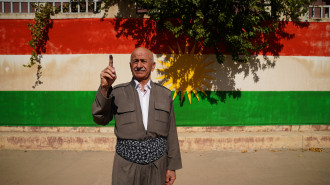Art flowed like life from Ghalib Halasa's pen
Can life be measured by how much one writes? Ghaleb Halasa (1932-1989) once posed this question in protest against the late Syrian novelist Hani al-Raheb (1939-2000), who said he stopped smoking because he wanted to live a few more years to be able to write more novels.
Halasa posed the question not so much in protest against the idea of writing, as against the idea of replacing the desire to live in freedom with the desire to write more stories, that is, at the expense of the key story: living.
On Friday, it was the 25th anniversary of his death in Damascus, and we remember Halasa for his essential idea:
| It is impossible to separate Halasa's way of life and his style of writing. |
Life is a text in a dialectical state of interaction between people, and between people and nature and the world around them. It is, therefore, a text yet to be written, or perhaps a text that will never be written. No one can claim they fixed life into a written text and stopped the dialogue between people and their surrounding reality. All of this - we and the facts, illusions, events, images, and memories surrounding us - will remain in what we can call the "beyond-the-text" state.
We, and whatever we can write, understand, and consider, are yet to come, that is, we are open to numerous possibilities and not hostage to a chronology where images, events, and ideas evolve in sequence.
From the first moment I saw Ghaleb in the early 1980s, I was attracted to his tendency to think of concrete things and stay away from abstract ideas and characters that lack specific places and times. I am not referring to his book, The World is Material and Movement, in which he touched upon the ideas of the Mu'tazilite Ibrahim al-Nazzam (Mu'tazila was an early Islamic school of theology), I am rather talking about the pattern of walking the untrodden path of thinking.
As we walked one evening in a traditional neighbourhood, Ghaleb suddenly said, as if he were talking to himself: "In old Arabic story-telling, Arabs went out of their houses looking for food, wandering between here and there throughout the day, only to find nothing. They go back home hungry at the end of the day. But there was always a home."
To me, this idea was an epiphany. The way he said it, slowly and quietly, made me feel he had contemplated this thought for a long time. Perhaps the fact that he did not have a house and spent long years away from his birthplace, Maan, haunted him. I would later realise that this was not only his way of thinking, but also his way of life.
I mean we are talking about an extraordinary writer, obsessed with words like "home", "family", "friends" and "village" or, in other words, with anything that carried an undertone of a tangible, intimate life, of a forgotten, unknown, and neglected life; and of possibilities about to be born or those that died in oblivion. The mission of the writer/artist was to salvage these possibilities from nothing, mould them into a text, and give them the chance to survive and triumph over time.
Text imitates life
In this context, there is a combination of what a writer lives and what they write. It is impossible to separate Halasa's way of life and his style of writing. Being aware of the first leads us to a deeper awareness of his literature. This situation can only be understood within the context of an idea about the writer and his writing itself that is completely different from traditional, popular ideas about writing.
Traditionally, writing is seen as a profession similar to that of an actor, who takes off his costume soon after the play is over. Writing a literary text cannot be likened to acting though. It rather represents the desire of a human being to live and be full of life, whether he did that while writing, lecturing, walking by the wall of a garden, or sitting in a cafe.
| There are no symbols in the world of Halasa, but rather things present in and for themselves. |
Halasa writes like the Japanese who see beauty in the whims and chaos of nature, not in how we organise it. The Japanese garden, where falling tree leaves and rough stones are scattered, is immeasurably more beautiful than a spruced-up English garden of roses.
This is why I one day wrote that it is difficult to remember a human like Ghaleb without feeling that he does not listen to the echoes of words, their noise or their silence. You would rather remember him - as he wanders, writes, thinks, or observes things - being attracted to that which is concrete and overwhelmed by a feeling that nothing can equal life.
I just said that this is a "beyond-the-text" state. By this, I mean the state where words become a living memory that expresses itself spontaneously without the ironies of the language. This means we can travel back in time, surpassing the boundaries between the present and the future. With this spontaneous and simple spirit, I read the novels of Halasa.
His are expressive, experimental works of literature, not silent works that readers examine as they might do a sequence of numbers and symbols. There are no symbols in the world of Halasa, but rather things present in and for themselves. There is no face that can act on behalf of another and no life that can replace another. Every person in this life has their peculiar nature and distinctive features, as well as a distinctive tone, sound, and colour.
There can be no art without discovering that distinctive nature and even going deeper to reach the highest point of distinctiveness. Can an artist capture all this if they are not full of life?
This is an edited translation from our Arabic edition.

![Palestinians mourned the victims of an Israeli strike on Deir al-Balah [Getty]](/sites/default/files/styles/image_684x385/public/2024-11/GettyImages-2182362043.jpg?h=199d8c1f&itok=xSHZFbmc)


![The law could be enforced against teachers without prior notice [Getty]](/sites/default/files/styles/image_684x385/public/2178740715.jpeg?h=a5f2f23a&itok=hnqrCS4x)
 Follow the Middle East's top stories in English at The New Arab on Google News
Follow the Middle East's top stories in English at The New Arab on Google News


